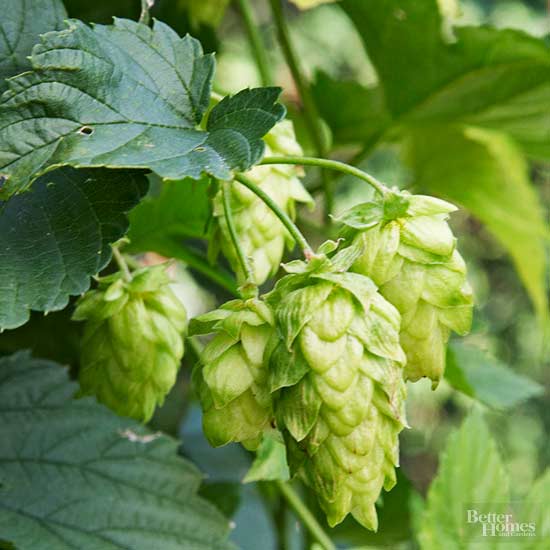






The part of the plant that is used to make beer is the flower of the Humulus lupulus. The little green pinecone-looking flower is also called a strobilus or seed cone. From a gardener's perspective, a hop plant is a perennial vine that grows up to 25 feet long (in a single season!). From a brewer's perspective, hops are an essential ingredient for beer. Initially hops were used to preserve beer; they were added to the cask after the beer was fermented to keep it fresh. Hops add distinctive flavor to beer, delivering a hoppy flavor that is described as bitter or zesty (as in citrus zest). Ales, German-style pilsners, and IPAs, are considered hoppy and can thank the flowers of this vine for their distinctive flavor.
continue reading belowThere are many varieties of hops, and they fall into two categories when using them for beer making: bitter and aroma hops. Bitter hops have high alpha acids. Aromatic hops have low alpha acids. Some varieties are a mix of bitter and aroma hops genetics. Look for the alpha acid percentage when buying hops varieties that match the type of beer you want to make. NOTE: There are ornamental hops, such as Humulus lupulus 'Aureus', which are not used for making beer.
Aromatic hops
'East Kent Golding' is a traditional English hop cultivated since 1790. (Alpha acid percent: 4-6%)
'Fuggle' is an English hop that matures early but is susceptible to Verticillium wilt. (Alpha acid percent: 4.5-5%)
'Willamette' adds fruit, flower, and spice. (Alpha acid percent: 4-6%)
Bittering hops
'Newport' has a strong resistance to downy and powdery mildew. (Alpha acid percent: 14.5-17%)
'Pacific Sunrise' adds woody notes and pine. (Alpha acid percent: 12.5-14.5%)
Dual purpose hops
'Cascade' is a hop developed by Oregon State University that has a spicy, grapefruit flavor. (Alpha acid percent: 4.5-7%)
'Centennial' is a genetic mix of several English and European hops. It has a strong citrus scent. (Alpha acid percent: 9.5-11.5%)
'Chinook' has a spicy, piney flavor. (Alpha acid percent: 12-14%)
'Northern Brewer' is an English native with a mix of bitter and aromatic hops. (Alpha acid percent: 7-10%)
Hops are sold by seed or rhizomes. To get a faster yield, choose rhizomes, which are little pieces of root covered with buds that produce vines. Many garden plants such as irises, peony, cannas, and dahlias, are grown from rhizomes.
Hops are dioecious, which means they are male and female. The females produce flowers; the males produce pollen. For beer making, you want flowers, so choose female rhizomes. You don't need a male plant because it doesn't matter if the cones are pollinated.
Here is what you need to grow hops successfully in your backyard:
LIGHT: Full sun
EXPOSURE: A nonwindy location
SOIL: Well-drained soil
ZONES: 4-9
SPRING
Erect support systems.
Hops need to be supported off the ground, so create a structure such as a tepee or large trellis that is at least 6 feet tall and as high as 15 feet tall.
Plant rhizomes.
Place in well-drained soil, about three feet apart. Add a layer of mulch around the plants.
Test soil for nutrient needs.
A soil test will help you determine what kind of nutrients you may need to add to your soil. Testing can be done through your local agricultural extension service. Generally, you'll need to add nitrogen and potassium in spring.
Train vines upward.
Hops are vines and grow upward. When they are about a foot long, train them on the structure.
SUMMER
Water and weed.
Keep the plants well hydrated and make sure there aren't weeds at the base of the plants to compete for water and nutrients.
FALL
Harvest flowers.
Depending on the variety and location, hops are available for harvest in mid August to mid September. The cones will be papery and have a strong scent. The lower bracts of the cone may be browned. Pick the cones and dry naturally, in a food dehydrator, or oven. Brewing experts recommend drying at low heat to maintain the aromatic qualities of the hops flowers. Generally one vine will produce ½ to 2 pounds of dried hops flowers.
LATE WINTER
Cut back vines.
Prune off the dead vines from the base of the plant. As the weather warms, new shoots will emerge from the crown of the plant.
Copyright © www.100flowers.win Botanic Garden All Rights Reserved